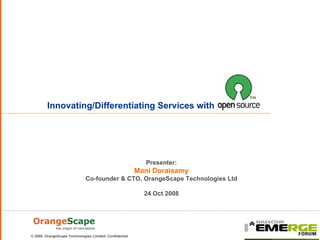Innovating/Differentiating Services with Opensource
- 1. Presenter: Mani Doraisamy Co-founder & CTO, OrangeScape Technologies Ltd 24 Oct 2008 ┬® 2008, OrangeScape Technologies Limited. Confidential Innovating/Differentiating Services with
- 2. What is Google into? ┬® 2008, OrangeScape Technologies Limited. Confidential Advertising Massive processing and storage Search Business model Investors Utility (Social/Business) Customers Technology Architects
- 3. Differentiate on Utility ┬® 2008, OrangeScape Technologies Limited. Confidential Always differentiate on Utility if you are an IT company; DonŌĆÖt innovate on Utility unless you ran that business earlier. Differentiation has to translate into customer understandable benefit Google has just one substantial differentiation: Quality of Search ŌĆśDepthŌĆÖ is important than the ŌĆświdthŌĆÖ of the benefit Utility (Social/Business) Customers Cost Time Quality
- 4. Innovate on Technology ┬® 2008, OrangeScape Technologies Limited. Confidential Technology is your secret sauce to dramatically improve Utility value In Google Technology Architects Page Rank - Dramatically improves Quality of Search Web Scale Computing on Commodity Hardware - Reduces cost of Search
- 5. Innovate on Technology ŌĆō Why? ┬® 2008, OrangeScape Technologies Limited. Confidential Technology innovation establishes credibility (and feasibility of differentiation) Differentiation will be copied once Utility is established i.e. when market is created - Technology will be the entry barrier for big companies to capture your market Technology innovation allows you to create new utility/market i.e. scales - Gmail, Google docs are all based on the same web scale platform Technology Architects
- 6. Open SourceŌĆō Where does it stand today? ┬® 2008, OrangeScape Technologies Limited. Confidential Most obvious utility value - Cost Typically degrades Time and Quality utility value Does not have entry barrier when used as it is Has platform adoption, not application adoption
- 7. Open Source ŌĆō Opportunities ┬® 2008, OrangeScape Technologies Limited. Confidential - Cost benefit is already realized - Might look for time/quality benefit Might look for cost benefit Will not compromise on quality Open Source platforms Proprietary applications Customers Build tools/processes for Open Source platforms to improve time, quality Augment customizable application components to open source application v
- 8. Open Source ŌĆō Model 1 ŌĆō Tools/Processes for Open Source platforms ┬® 2008, OrangeScape Technologies Limited. Confidential Resource Monitoring, Administration, Escalation (JConsole, JMX) for Application servers (e.g. JBoss, Tomcat) Tuning - Configuration, Caching for Web servers, Application servers, Database Performance Testing (Apache JMeter) for Web applications Scaling - Load balancing, Clustering and Replication (C-JDBC) for Web servers, Application server, Databases Integration (Mule), ETL (Pentaho Data Integration) for Application, Databases
- 9. Open Source ŌĆō Model 2 ŌĆō Customizable Application Components to Open Source Applications ┬® 2008, OrangeScape Technologies Limited. Confidential SugarCRM ŌĆō Conversion confidence measurement system Compiere ERP ŌĆō Textile industry, Machine tools industry specific processes Asterisk Telephony ŌĆō Support effectiveness system, Spend monitoring system
- 10. Final thoughts on Business model ┬® 2008, OrangeScape Technologies Limited. Confidential If you have built substantial quality benefit, you may (or) may not decide to pass the open source cost benefit to customers You can choose more revenue (by passing on cost benefit) Vs more profit (by retaining cost benefit) If you are a small company you should opt for profit during the initial stages -Founders tend to be aggressive with maturity cycle and underestimate actual cost -Have buffer to be prepared for price war when big companies join the race
- 11. Discussion ┬® 2008, OrangeScape Technologies Limited. Confidential
- 12. Thank You ┬® 2008, OrangeScape Technologies Limited. Confidential












